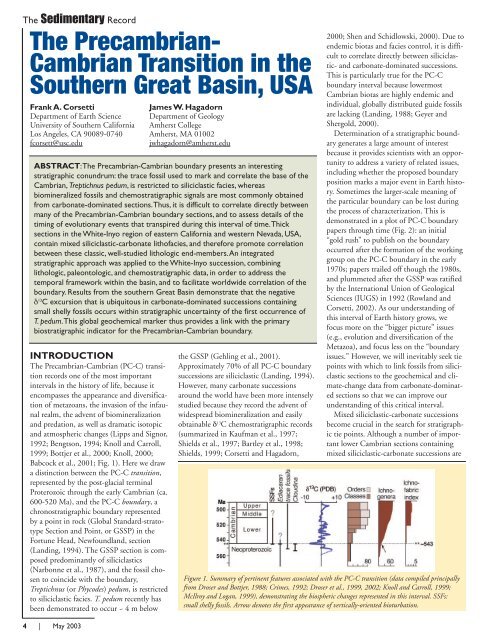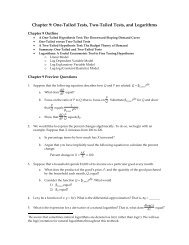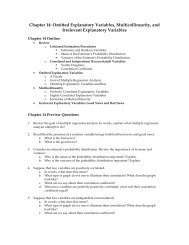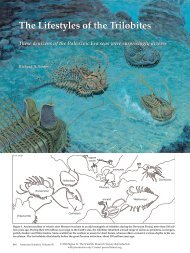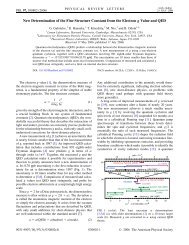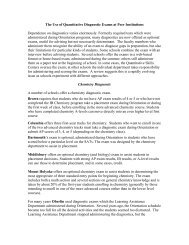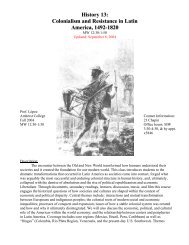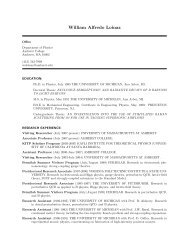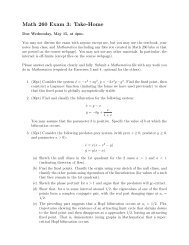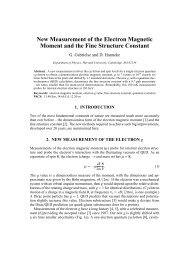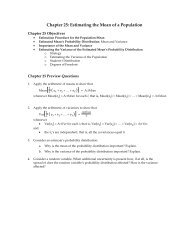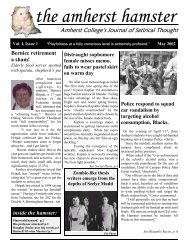sedimentary sedimentary - SEPM
sedimentary sedimentary - SEPM
sedimentary sedimentary - SEPM
Create successful ePaper yourself
Turn your PDF publications into a flip-book with our unique Google optimized e-Paper software.
The Sedimentary Record<br />
The Precambrian-<br />
Cambrian Transition in the<br />
Southern Great Basin, USA<br />
Frank A. Corsetti<br />
Department of Earth Science<br />
University of Southern California<br />
Los Angeles, CA 90089-0740<br />
fcorsett@usc.edu<br />
ABSTRACT:The Precambrian-Cambrian boundary presents an interesting<br />
stratigraphic conundrum: the trace fossil used to mark and correlate the base of the<br />
Cambrian, Treptichnus pedum, is restricted to siliciclastic facies, whereas<br />
biomineralized fossils and chemostratigraphic signals are most commonly obtained<br />
from carbonate-dominated sections.Thus, it is difficult to correlate directly between<br />
many of the Precambrian-Cambrian boundary sections, and to assess details of the<br />
timing of evolutionary events that transpired during this interval of time.Thick<br />
sections in the White-Inyo region of eastern California and western Nevada, USA,<br />
contain mixed siliciclastic-carbonate lithofacies, and therefore promote correlation<br />
between these classic, well-studied lithologic end-members.An integrated<br />
stratigraphic approach was applied to the White-Inyo succession, combining<br />
lithologic, paleontologic, and chemostratigraphic data, in order to address the<br />
temporal framework within the basin, and to facilitate worldwide correlation of the<br />
boundary. Results from the southern Great Basin demonstrate that the negative<br />
δ 13 C excursion that is ubiquitous in carbonate-dominated successions containing<br />
small shelly fossils occurs within stratigraphic uncertainty of the first occurrence of<br />
T. pedum.This global geochemical marker thus provides a link with the primary<br />
biostratigraphic indicator for the Precambrian-Cambrian boundary.<br />
INTRODUCTION<br />
The Precambrian-Cambrian (PC-C) transition<br />
records one of the most important<br />
intervals in the history of life, because it<br />
encompasses the appearance and diversification<br />
of metazoans, the invasion of the infaunal<br />
realm, the advent of biomineralization<br />
and predation, as well as dramatic isotopic<br />
and atmospheric changes (Lipps and Signor,<br />
1992; Bengtson, 1994; Knoll and Carroll,<br />
1999; Bottjer et al., 2000; Knoll, 2000;<br />
Babcock et al., 2001; Fig. 1). Here we draw<br />
a distinction between the PC-C transition,<br />
represented by the post-glacial terminal<br />
Proterozoic through the early Cambrian (ca.<br />
600-520 Ma), and the PC-C boundary, a<br />
chronostratigraphic boundary represented<br />
by a point in rock (Global Standard-stratotype<br />
Section and Point, or GSSP) in the<br />
Fortune Head, Newfoundland, section<br />
(Landing, 1994). The GSSP section is composed<br />
predominantly of siliciclastics<br />
(Narbonne et al., 1987), and the fossil chosen<br />
to coincide with the boundary,<br />
Treptichnus (or Phycodes) pedum, is restricted<br />
to siliciclastic facies. T. pedum recently has<br />
been demonstrated to occur ~ 4 m below<br />
4 | May 2003<br />
James W. Hagadorn<br />
Department of Geology<br />
Amherst College<br />
Amherst, MA 01002<br />
jwhagadorn@amherst.edu<br />
the GSSP (Gehling et al., 2001).<br />
Approximately 70% of all PC-C boundary<br />
successions are siliciclastic (Landing, 1994).<br />
However, many carbonate successions<br />
around the world have been more intensely<br />
studied because they record the advent of<br />
widespread biomineralization and easily<br />
obtainable δ 13 C chemostratigraphic records<br />
(summarized in Kaufman et al., 1997;<br />
Shields et al., 1997; Bartley et al., 1998;<br />
Shields, 1999; Corsetti and Hagadorn,<br />
2000; Shen and Schidlowski, 2000). Due to<br />
endemic biotas and facies control, it is difficult<br />
to correlate directly between siliciclastic-<br />
and carbonate-dominated successions.<br />
This is particularly true for the PC-C<br />
boundary interval because lowermost<br />
Cambrian biotas are highly endemic and<br />
individual, globally distributed guide fossils<br />
are lacking (Landing, 1988; Geyer and<br />
Shergold, 2000).<br />
Determination of a stratigraphic boundary<br />
generates a large amount of interest<br />
because it provides scientists with an opportunity<br />
to address a variety of related issues,<br />
including whether the proposed boundary<br />
position marks a major event in Earth history.<br />
Sometimes the larger-scale meaning of<br />
the particular boundary can be lost during<br />
the process of characterization. This is<br />
demonstrated in a plot of PC-C boundary<br />
papers through time (Fig. 2): an initial<br />
“gold rush” to publish on the boundary<br />
occurred after the formation of the working<br />
group on the PC-C boundary in the early<br />
1970s; papers trailed off though the 1980s,<br />
and plummeted after the GSSP was ratified<br />
by the International Union of Geological<br />
Sciences (IUGS) in 1992 (Rowland and<br />
Corsetti, 2002). As our understanding of<br />
this interval of Earth history grows, we<br />
focus more on the “bigger picture” issues<br />
(e.g., evolution and diversification of the<br />
Metazoa), and focus less on the “boundary<br />
issues.” However, we will inevitably seek tie<br />
points with which to link fossils from siliciclastic<br />
sections to the geochemical and climate-change<br />
data from carbonate-dominated<br />
sections so that we can improve our<br />
understanding of this critical interval.<br />
Mixed siliciclastic-carbonate successions<br />
become crucial in the search for stratigraphic<br />
tie points. Although a number of important<br />
lower Cambrian sections containing<br />
mixed siliciclastic-carbonate successions are<br />
Figure 1. Summary of pertinent features associated with the PC-C transition (data compiled principally<br />
from Droser and Bottjer, 1988; Crimes, 1992; Droser et al., 1999, 2002; Knoll and Carroll, 1999;<br />
McIlroy and Logan, 1999), demonstrating the biospheric changes represented in this interval. SSFs:<br />
small shelly fossils. Arrow denotes the first appearance of vertically-oriented bioturbation.


